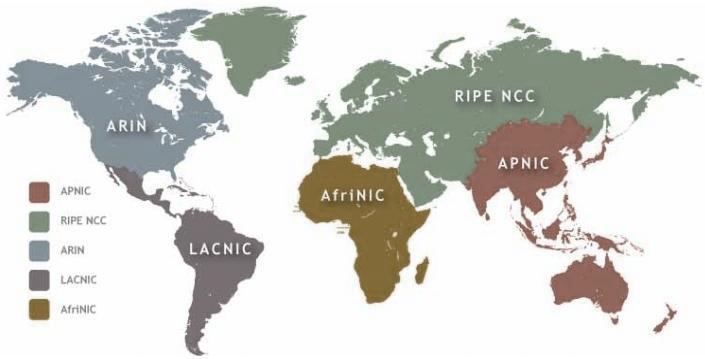Each machine, which is connected to the Internet, has its own IP address. The IP address is used to identify it to the world and plays an important part in the TCP/IP protocol. Usually, an IP address is displayed as a group of numbers, separated by dots.
![]() Abstraction only understood by software
Abstraction only understood by software
![]() Independent of hardware addressing
Independent of hardware addressing
![]() Used by TCP/IP protocols and other application programs
Used by TCP/IP protocols and other application programs
![]() 32-bit integer
32-bit integer
![]() Does not identify a specific computer
Does not identify a specific computer
![]() Identifies a connection between a computer and a network
Identifies a connection between a computer and a network
![]() Unique value for each host (global IP verse local IP address)
Unique value for each host (global IP verse local IP address)
![]() May have more than one IP addresses for a computer with
May have more than one IP addresses for a computer with
multiple network connection, e.g., a router
![]() Classful IP addressing
Classful IP addressing
![]() Subnet and Classless IP addressing
Subnet and Classless IP addressing
![]() Assigned by global authority (IANA & ISP) and local administrator
Assigned by global authority (IANA & ISP) and local administrator
The numbers in the IP address are called octets. The name "octets" derives from the positions the numbers can have in the binary form of the IP address, which is actually used by computers. The "215.65.1.240" type of address is used for human understanding.
The octets in the IP address play another important role – they divide the IP addresses into classes. They are split into two sections – net and host. The Net section always starts with the first octet and is used to define the network the machine belongs to. The Host section defines the actual machine in the network and always contains the last octet.
Private addresses are the addresses people use on private networks, such as many home and ofce
networks. At a protocol level there is no diference between the addresses, but organizationally, private
addresses are distinct because they can only be used within a single administration and not on the
wider Internet. This is because private addresses are set aside for use by anyone without any global
coordination. You can know an address is from a block of private addresses if it:
■ Begins with 10. (i.e. 10.0.0.0 through 10.255.255.255)
■ Begins with 172.16. through 172.31.
■ Begins with 192.168.
These addresses are the defaults used in a lot of plug’n’play networking equipment, like that sold to
residential Internet users. Unique addresses are diferent only in that their distribution is managed by
a set of registries. Because the registries manage the distribution of the other addresses, it is possible
to know who an address is assigned to and how to get in contact with them. These types of addresses
allow data to be routed across the whole Internet.
If your computer is assigned a private address, but you can still access services over the Internet, then
your computer is probably behind a Network Address Translator (NAT), which lets lots of computers
share a single unique IP address.
IP addresses are distributed in a hierarchical system. As the operator of Internet Assigned Numbers
Authority (IANA) functions, ICANN allocates IP address blocks to the fve Regional Internet Registries
(RIRs) around the world:

IANA assigns addresses based on globally agreed-upon rules, or policies. The key policy
elements for IPv4 were:
■ RIRs received IPv4 blocks in /8 units from IANA.
■ RIRs could receive an additional block when they had just one half of a block left.
■ The number of /8 units RIRs received was based on a formula established by IANA.
Two policies governed the allocation of IPv4 addresses to the RIRs. The regular policy was called the Policy
for Allocation of IPv4 Blocks to Regional Internet Registries and governed how IPv4 addresses were
allocated to RIRs since April 2005. The second, called the Global Policy for the Allocation of the Remaining
IPv4 Address Space, governed how the last fve IPv4 /8s were allocated. It was ratifed in March 2009.
ICANN’s Board of Directors ratifed the policy governing the allocation of IPv6 address
space to RIRs in September 2006. The key policy elements are:
■ RIRs receive IPv6 blocks in /12 units.
■ RIRs can receive an additional block when they have just one half of a block left.
■ The number of /12 units RIRs receive is based on a formula established by IANA.
The IP address is usually expressed as four decimal numbers, each representing eight bits, separated by periods.
![]() The class A IP addresses have a first or Net octet in the range of 1 and 126. The other three octets define the hosts. The A class network allows for a total of 2,147,483,648 unique IP addresses and is mainly used for the network of a very large corporation.
The class A IP addresses have a first or Net octet in the range of 1 and 126. The other three octets define the hosts. The A class network allows for a total of 2,147,483,648 unique IP addresses and is mainly used for the network of a very large corporation.
![]() The class B IP addresses use the first two octets as network identifiers, and the last two as host identifiers. The first octet in the class B IP addresses is in the 128 to 191 range. IPs from this class are most commonly used by mid-sized networks, such as college campuses
The class B IP addresses use the first two octets as network identifiers, and the last two as host identifiers. The first octet in the class B IP addresses is in the 128 to 191 range. IPs from this class are most commonly used by mid-sized networks, such as college campuses
![]() For class C, the Net identifier is composed of the first 3 octets and the first octet is in the 192 to 223 range. The last octet is used to identify the host. With a limited number of hosts, this IP class is suitable for small to mid-sized networks.
For class C, the Net identifier is composed of the first 3 octets and the first octet is in the 192 to 223 range. The last octet is used to identify the host. With a limited number of hosts, this IP class is suitable for small to mid-sized networks.
![]() IP addresses from D class are mostly used for multicasting. They are in the 224.0.0.0 to 239.255.255.255 range. The 224.0.0.0 to 224.0.0.255 range is used only for local area network (LAN) multicasting.
IP addresses from D class are mostly used for multicasting. They are in the 224.0.0.0 to 239.255.255.255 range. The 224.0.0.0 to 224.0.0.255 range is used only for local area network (LAN) multicasting.
![]() IP addresses in E class have the first octet in the 240-255 range. They are reserved for experimental usage and computers, trying to use them will not be able to communicate properly online.
IP addresses in E class have the first octet in the 240-255 range. They are reserved for experimental usage and computers, trying to use them will not be able to communicate properly online.
When looking at a standard IPv4 address, one can easily see that it has a finite number of combinations for unique IP addresses and that at some point, they will be over. This is why the IPv6 IP address was created. The IPv6 address is expected to launch worldwide in late 2010 or 2011, when the IPv4 addresses will reach their limit. The new address is of 128 bits (IPv4 is 32bit), which will be enough for at least 100 years in the future, even if the growth of the Internet users increases.
Dotted Decimal Notation of IP Addresses
![]() 32 bit binary number is hard to remember
32 bit binary number is hard to remember
![]() Divide 32 bits into four 8-bit sections called octet
Divide 32 bits into four 8-bit sections called octet
![]() Express each octet as a decimal number between 0 to 255
Express each octet as a decimal number between 0 to 255
![]() Separate 4 decimal number by dot “.”
Separate 4 decimal number by dot “.”
![]() Easy for human and used by application programs
Easy for human and used by application programs
IP Addressing Principle for Router
![]() Router connects to multiple physical networks
Router connects to multiple physical networks
![]() Each physical network has a unique prefix (Netid)
Each physical network has a unique prefix (Netid)
![]() Router has multiple IP addresses, each for a connected network
Router has multiple IP addresses, each for a connected network
![]() Suffix in router IP address is assigned locally, like other host
Suffix in router IP address is assigned locally, like other host
![]() Same suffix in routers’ IP addresses can help network administration
Same suffix in routers’ IP addresses can help network administration
more about IPv6
more from Wikipedia
more from Webopedia
more from Youtube

















